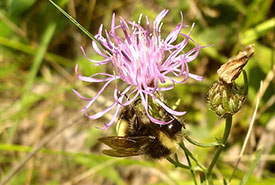Megan Evans-Alberta Native Bee Council, President

Yellow-banded bumble bee (Photo by Amanda Liczner)
What is the problem you are looking to solve or the question you are looking to answer?
The Alberta Native Bee Council's Citizen Science Bumble Bee Box Monitoring Program has several objectives. The first is to increase awareness of native bees in Alberta. The second is to create habitat for bumble bees and, finally, we hope to learn more about bumble bee nesting preferences and success in Alberta.
Can you give us a general description of the project?
Individuals can participate in the program by joining us for a bumble bee box building workshop or they can build their own bumble bee box using instructions provided on our website. Bumble bee boxes are placed outside once the snow has melted and over-wintered queen bees emerge from their hibernation and search for suitable nesting areas. Colonization rates in bumble bee boxes vary widely in the scientific literature, but local studies have routinely found about one in four boxes are colonized. We ask that participants report back in the fall on activity within their bumble bee box, and if participants are willing, we will pick up the nest contents for future study.
What will you learn from your project?
We hope to learn more about bumble bee nesting preferences and reasons for colony success and failure while providing educational opportunities for the public.
What is the biggest achievement of the project to date?
Our biggest success is increasing awareness of native bees in Alberta. In the first two years of the project, we have distributed over 1,000 bumble bee boxes at over 40 workshops and other events. This is incredible because we are a volunteer-run organization!
How can this project benefit NCC’s work and other conservation initiatives?
This project can benefit NCC’s work and other conservation initiatives by increasing our understanding of bumble bee colony success and nesting preferences and the potential for using the bee boxes as a conservation tool.
What is your favourite part of the project you are working on?
My favourite part of this project is talking to the public about bees. People are really interested in bees right now and there is a lot of information out there, but not all of it is good. It’s great to be able to provide up-to-date information about a topic that so many people are interested in. I also really love looking at the data at the end of the year!
What gets you excited about the species/habitat your project is investigating?
I get excited about bees in general! There are so many species and they’re all very different. I get to learn new things every day!
What is the impact you are hoping to achieve in Alberta (or beyond) with the project you are involved with?
We are hoping to raise awareness of native bees in Alberta and provide different ways that people can help them right in their own backyard.
Is there a place where people who are interested in your project can go to learn more?
Learn more about this project here.
Did you know?
- There are over 300 native bee species in Alberta.
- Most bees are solitary and live in the ground.
- There are no honey bees native to North America.
- Only female bees have stingers.
- Our native bees can sting repeatedly, unlike honey bees, which die after stinging.





